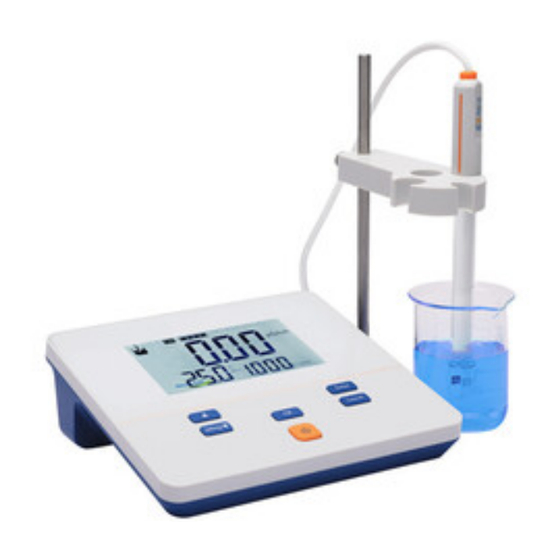
Advertisement
Quick Links
Advertisement

Summary of Contents for BioLAB BMET-301
- Page 1 OPERATING MANUAL CONDUCTIVITY METER BMET-301 www.biolabscientific.com...
- Page 2 INDEX 1 Introduction 1.1 Introduction 1.2 Technical Specification 1.3 Function Introduction 2 Safety Notices 3 Terms Explanation 4 Overview and Installation 4.1 Overview 4.2 Instrument Installation 5 Instrument Operation 5.1 Screen Icons 5.2 Key Function 5.3 Instrument Settings 5.4 Calibration 5.5 Measurement 6 Maintenance/Troubleshooting 6.1 Maintenance...
- Page 3 1 Introduction 1.1 Introduction BMET-301 Conductivity Meter can measure conductivity in water solution, and can be widely used in universities, environmental protection, medicine, food, sanitation, geological prospecting, metallurgy, ocean exploration. 1) General Features - LCD display screen, 6.0 inches. - Cell constant is settable.
- Page 4 continuous-read Reading Function Reading Mode Conductivity ● Cell constant set ● Measurement Manual temperature compensation (0.0°C~60.0°C) Temperature Function Temperature Unit °C 2 Safety Notices Please read the entire contents of this manual carefully before use, and please keep this manual properly.
- Page 5 4 Overview and Installation 4.1 Overview Fig. 4-1 Overview-Front View Fig.4-2 Overview- Back View www.biolabscientific.com...
- Page 6 Fig. 4-3 Electrodes and connectors Table 4-1 Connector Specifications Electrode type Connector specifications Conductivity electrode 5-pin aviation 4.2 Instrument Installation 4.2.1 Electrode Stand Installation 1) Screw the electrode stem into the screw hole of the insert plate. 2) Insert the round hole at the back of the electrode fixing clip into the electrode stem, adjust the height, and tighten the fixing screw.
- Page 7 5 Instrument Operation 5.1 Screen Icons The meter has 6.0 inches high resolution LCD display screen. The User interface has the menu, status, result. The menu has measurement and setting. The status shows the reading mode, reading prompts and auto shutdown etc. The result shows the conductivity, unit, temperature, cell constant type etc. Fig.
- Page 8 5.2 Key Function Fig. 5-2 The Screen and the Key Table 5-2 Key Function Explanation No. Key Explanation Note Switch on the meter by press and release the key. Switch off the meter by press and hold the key for more than 3 seconds Power Key and release.
- Page 9 Switch Off 5.3.2 Instrument Settings The meter has the parameter setting, such as Temperature Settings, Automatic shutdown settings, Reset settings. Press the “Setting/▼”, the meter shows the setting symbol, SEL and No. Press the up and down to adjust the parameter and select the Enter to select. Fig.
- Page 10 Fig. 5-5 Reset settings Table 5-5 Reset settings Explanation No. Symbol Note Reset Default Flashing display 5.4 Calibration 5.4.1 Calibration Preparation In common, there are two type calibrations. one is entering the cell constant value directly; the other is calibrating the conductance electrode with standard conductivity standard solution. There are many conductance electrodes in order to suit for different measurement range.
- Page 11 Fig. 5-6 Constant Type is 1.0, Cell constant is 1.000 Fig. 5-7 Constant Type is 1.0, Cell constant is 0.998 Fig. 5-8 Constant Type is 0.1, Cell constant is 0.0998 5.4.3 Calibration with standard In general, conductivity electrodes need few calibrations. When the user gets an unexpected result, an electrode calibration is considerable.
- Page 12 67.61 1147 10.48 75.80 1278 11.67 84.00 1413 12.88 92,19 1552 14.12 100.92 1696 15.39 The manual calibration process is as follows: - Place a standard conductivity (e.g., 1413μS/cm conductivity solution) solution in a thermostatic bath, and set the temperature to (25.0±0.1) °C. - Rinse the conductance electrode with DI water, dry out and place it into a standard solution.
- Page 13 Before using the electrode, you should read the electrode manual carefully to know the type, structure and application scope of the electrode. For more detailed information, please refer to the electrode instruction manual. Biolab Scientific Ltd. 3660 Midland Avenue, Suite 300, Toronto, Ontario M1V 0B8, Canada Email: info@biolabscientific.com | Website: www.biolabscientific.com...





Need help?
Do you have a question about the BMET-301 and is the answer not in the manual?
Questions and answers